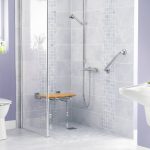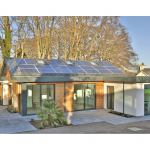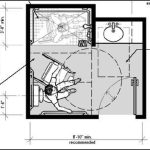As you explore home modifications to fit changes in your life, you may encounter unfamiliar terms like “accessible”, “inclusive”, or “universal” design.
What are the differences between these design concepts? Is one more suitable for your lifestyle than the others? Can Live in Place Designs work within any of these frameworks? Do you have to narrow it down to one?
In this article, we’ll focus on understanding what differentiates universal design from accessible or inclusive design – including the fact that some overlap does exist!
So What Exactly Is Universal Design?
First and foremost, “universal design” defines a design process rather than an end product. The goal is to create a design usable by anybody. In practice, this is imperfect, but it usually results in an end product or space that can be used by the broadest spectrum of people possible.
At Live in Place Designs, the universal approach comprises one of our design routes. We might also opt for inclusive or accessible design, which we’ll describe in more detail later. It all depends on your needs as a client.
How Did Universal Design Originate?
Although its prevalence has come to the forefront in recent years, the principles of universal design have been around since the late 90s.
Led by Ronald Mace of North Carolina State University, a group of working architects, product designers, engineers, and environmental design researchers banded together to develop the principles. They formed them to evaluate existing work and guide the creation of new work.
The principles of Universal Design are as follows:
Principle 1: Equitable Use
The design appeals to people of diverse abilities in usefulness and marketability.
Whenever possible, this is accomplished with the same means rather than segregation by ability. Equity also covers privacy, security, and safety for all users.
Principle 2: Flexibility in Use
The design takes a wide range of individual preferences and abilities into account, providing choices.
This could be as simple as right vs. left hand usage. It can also adapt to the user’s pace and personal preferences – and it should facilitate accuracy and precision.
Principle 3: Simple and Intuitive Use
The design is approachable, regardless of the user’s experience, knowledge, or level of concentration. With little frame of reference, the user can figure out how to interact with the product or space.
This takes into account varying backgrounds, i.e. education and literacy. The designer should strive to eliminate unnecessary complexity and deliver information in order of importance.
Principle 4: Perceptible Information
Different people learn in different ways (e.g., visual, auditory, kinesthetic). Some people also live with sensory limitates, like blindness, deafness, or partial impairments.
To make design more universal, designers take this into account when creating a product or experience. They present information in a variety of formats so that users can access via their preferred methods.
Redundancy is accomplished in a non-obtrusive way; that’s the art of the design. This is known as “maximizing legibility”.
Principle 5: Tolerance for Error
As legibility is maximized, the consequences of mistakes need to be minimized.
No design is perfect, and most users will need more than one try when encountering something for the first time.
To achieve this, a designer might include warnings, shields, and/or fail-safe features.
Principle 6: Low Physical Effort
Most products or environments are made for repeated use. For this reason alone, it makes sense to design with ease and efficiency in mind. The salience of this principle increases when designers embrace an array of user physical limitations.
In practice, designers want to see users maintain a neutral body position, use a reasonable amount of force to operate, refrain from repeating gestures, and work in short bursts rather than tough, sustained effort.
Principle 7: Size and Space for Approach and Use
This principle covers a basic fact of human life: we are all different sizes. Truly, there is no one-size-fits-all design. Universal design acknowledges and expands this reality to include posture, mobility, and dexterity. This could mean accommodating standing or sitting users; different hand strengths and grip abilities; and different space needs for mobile or assistive equipment.
You may notice that these principles resonate with a central theme: eliminating potential problems to open space for the most diverse population possible. When we get into accessible design in a separate article, you’ll see that the accessible approach takes it a step further:it proactively implements solutions in products and/or environments based on a particular individual’s needs.
Some organizations, like the Institute for Human Centered Design, have switched to the term “inclusive design” in recent years. We regard inclusive design as a sibling to universal design, one that straddles accessible and universal, because it focalizes the needs of an individual without losing sight of the larger group.
Briefly: Where Can Universal Design Be Employed?
Although the focus of this article is home design, we do want to touch on common universal design applications. Where are you likely to see universal design principles at work?
The short answer: everywhere.
Besides housing, we have seen universal design principles applied with great efficacy to website usability, public transportation, kitchen products, educational spaces, pedagogical tools, and civic buildings, from courthouses to museums.
For many older builds, designers must integrate the principles in retrofitting rather than construction. You’ll find universal design in a residence plays out in a similar way.
Applying Universal Design to the Home
Does your home need a universal, inclusive, or accessible design approach? This is one of the first questions that your designer will ask. It’s an applicable question whether you’re building, refurbishing, or even searching for a new house.
The answer to this question depends on present circumstances, future projections, budget, and how much “slack” the timeline allows. For instance, if you plan to return from a rehabilitation center with new, permanent or indefinite motor limitations, you will want to renovate your home with lasting solutions, as soon as possible. The design will call for an accessible angle, tailored to your specific needs.
On the other hand, let’s say you are the child of aging parents. You plan to add a new garage and game room to the house with general anticipation that, at some point in the future, your parents might move in with you.
Currently, they’re not experiencing notable restrictions or illnesses. But you can imagine that, as they age, they may eventually need your care and supervision. They’ll also need extra space for walkers or wheelchairs, as well as some supportive mechanisms in daily living arrangements.
This situation would call for a more universal (or perhaps inclusive) design process. Your designer would strive to create a multi-functional space. They would predict obstructions to an aging person’s routine and circumvent them in the build plans. This could translate into wider doorways, a bathroom with a walk-in shower, and an easily navigable kitchen space. The designer could leave certain features open for modification, i.e. enough leeway around the toilet and shower areas to add grab bars later.
If you’re renovating an existing space, the approach would be similar. Instead, the designer might root out already-present problems. They would propose remodel options that open accessibility to a wide array of ages and abilities. This should lead to greater comfort and ease for all family members, not just in the hypothetical aging future.
If you’d like to read more about our take on Universal Design, see our comments in the Porch article: 
Home Safety Tips for Seniors: A Comprehensive Guide to General Safety Measures
Dispelling Myths of Universal Design
So far, we hope you’ve gained a clearer understanding of universal design from learning its general principles and some concrete examples.
We’d also like to acknowledge that the term comes with certain misconceptions. We feel it’s necessary to clear up some of these assumptions.
Universal design is not:
- Diluted. Universal design does not claim to be “one-size-fits-all”. It doesn’t assume that one form of anything – door handle, kitchen range, public transit path, appliance – will work for all people. It does, however, commit to choices, condensed into the smallest number of versatile options possible.
- Utilitarian at All Costs. On the contrary, aesthetics form an essential part of a design’s functionality. The product or space needs to feel approachable and visually harmonious. A consumer will actually rate a product “more useful” if it includes pleasing aesthetics, even if there’s no functional difference present.
- Conspicuous. Especially in homes, universal design should not stand out upon first viewing. Ideally, a visitor to the home might use descriptions like “open”, “modern”, “spacious”, or “nice flow” before words pertaining to mobility, accessibility, or inclusion come up. This is not to hide the designer’s intention or the visibility of the user. Rather, it’s to normalize inclusivity in design.
Consult with Live in Place Designs
At Live in Place Designs, we combine our knowledge in healthcare, home construction, and design to create a space where you and your loved ones can flourish – regardless of age or ability.
Our process starts with the individual(s) who will inhabit the space. Much like modern UX/UI, we front-load our design process with interviews and intentionality. We talk directly to the client, and we observe them in their daily routine.
In addition, we might consult the client’s family, healthcare provider, builder, and any other relevant players in the creation of the home. We may ask an occupational therapist to perform an assessment like I-HOPE (In-Home Occupational Performance Evaluation) to give benchmarks for improvement of home usability. From these initial steps, we determine which direction your house design should go: accessible, universal, or blended inclusive.
Ultimately, we tailor the process to each situation. The labels serve to direct our process toward a home that sustains your life as it is now and as it develops in the future.






